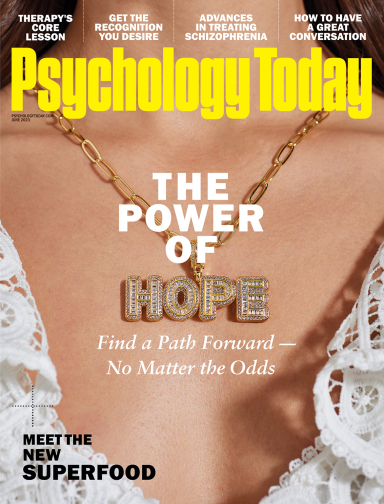Relationships
Is It Love or Desire?
Research shows that romantic love and infatuation are different.
Posted May 5, 2016
I was recently trying to make sense of data examining a group of 19 newlyweds’ brain scans approximately one-year after their wedding. It seems that infatuation tends to decrease over time in relationships (Acevedo & Aron, 2009). I wonder if this is Mother Nature’s saving grace and whether it may help us to see clearly beyond the fog of passion.
Romantic love or even infatuation is not the issue. The problem for many is the confusion of love and obsession. Many believe that if they are not experiencing the dopamine and adrenaline induced highs of new love, that then surely they must not be in love. It can be addictive to feel the throes of uncontrollable and insatiable passion. However, with this comes a price, as these situations are also full of uncertainty, anxiety, emotional highs and lows; and intrusive thoughts, feelings, and urges.
Many scientists, such as Helen Fisher and myself, believe that infatuation is not supposed to last. Mainly, its purpose is thought to bring couples together to focus intensely on each other to solidify their relationships (or pair-bonds). Of course, for some this goes hand-in-hand with mating, and having and raising children (a noble deed that perhaps would not prevail without passion). It’s also possible that a highly infatuated long-term marriage could undermine familial or social responsibilities.
Indeed, long-term, obsession does not promote our best interests. For example, a meta-analysis of 25 studies showed that that infatuation (characterized by pining, emotional rollercoasters, uncertainty, and insecurity) was negatively associated with relationship satisfaction in lasting marriages (Acevedo & Aron, 2009). However, romantic love (with engagement, intensity, and sexual interest, but without obsession) was positively associated with satisfaction.
Other work suggests that romantic love (with low obsession) is also associated with higher self-esteem, while obsession is not (e.g.,Campbell, Foster, & Finkel, 2002). The direction of causality could be from self-esteem to love. For example, adults classified as “secure” (according to attachment theory), tend to report higher self-esteem (e.g., Treboux et al., 2004). Having the felt security that a partner is “there for you,” not only makes for a smooth functioning relationship but also makes it easier to trust and relax into romantic love. In contrast, individuals classified as “insecure” are less effective at using and providing a consistent secure base for their partners, have lower satisfaction and greater conflict in relationships, and also report lower self-esteem. Such events may heighten feelings of insecurity about the relationship, and could manifest as obsessive love.
So if romantic love is clearly good for us, while obsession (tempting us with its rush) over time reveals its true colors, why do many still get hooked? Some scientists have started to think about the links between romantic love and addiction. In fact, many of the neural circuits shown in studies of romantic love also appear in studies with addictive substances—from monetary rewards, to cocaine, and even food. In a sense the human drive to form pair-bonds and raise successful offspring is essential for the survival and thriving of the species. Some scientists have extrapolated to altruism (defined as behaviors which benefit another with either no gain or some immediate cost to the self suggesting that it emerged to protect social groups—both kin and nonkin (Silk, 2007). For example, in animals “reproductive altruism” where non-parents (such as helper offspring that could leave the nest) help raise offspring is often cited (Silk et al., 2005; Griesser & Suzuki, 2016).
Thus, beyond romance and mating, love may serve to keep couples together over time, providing them with friendship, care and companionship. According to attachment theory, the “caregiving system”—an innate behavioral system that responds to the needs of dependent others (Bowlby, 1969; Ainsworth, Waters, & Wall, 1978; Mikulincer et al, 2005), evolved to complement the attachment system. The attachment system is a species-specific system that is thought to have evolved to increase chances of species survival by providing a physiological alarm system that responds to safety and harm by either seeking proximity to the attachment figure or exploration of the environment.
What can we take away from all this? Love and relationships (when in balance and harmonious) can be a “healthy” addiction, like going to the gym or taking naps. These relationship- and health-promoting behaviors help to keep us happy and healthy. For example, marital satisfaction predicts global happiness, above and beyond other types of satisfaction (e.g., Glenn & Weaver, 1981). It is also associated with psychological well-being and physical health (e.g., Drigotas, Rusbult, Wieselquist, & Whitton, 1999). On the other hand, low relationship quality is a major predictor of depression and divorce (e.g., Beach & O’Leary, 1993). Indeed, love is complex. It involves intensity, passion, friendship, caring, commitment, but also infatuation. There are many benefits to being in a healthy partnership, so take the first step and discern what is going really well in your relationship, and what can use a little fine-tuning.








![By Beercha (Flickr: -15C Ziemā) [CC BY 2.0 (http://creativecommons.org/licenses/by/2.0)], via Wikimedia Commons](https://cdn2.psychologytoday.com/assets/styles/manual_crop_3_2_600x400/public/field_blog_entry_teaser_image/2017-06/woman_face_covered_in_ice.jpg?itok=pdLeAkmk)
















